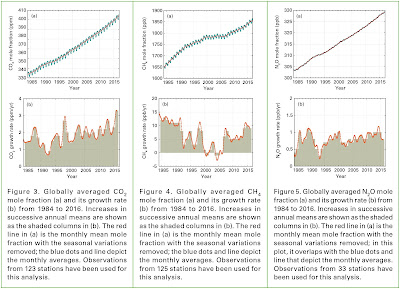世界気象機関(WMO;World Meteorological Organization)の10月30日の発表 “Greenhouse gas concentrations surge to new record” によると、二酸化炭素(CO2)、メタン(CH4)、亜酸化窒素(N2O)の3大温室効果ガスについて、2016年での世界平均濃度が過去最高を更新した。
詳細は、WMOが作成した報告書 “WMO Greenhouse Gas Bulletin” を参照されたい。
2017.10.30 WMO “Greenhouse gas concentrations surge to new record”
2016年において、CO2濃度は403.3±0.1ppm、CH4濃度は1853±2ppb、N2O濃度は328.9±0.1ppb で、それぞれ工業化以前の頃よりも145%増、257%増、122%増であった。
《原文より抜粋》
The latest analysis of observations from the WMO GAW Programme shows that globally averaged surface mole fractions calculated from this in situ network for CO2, methane (CH4) and nitrous oxide (N2O) reached new highs in 2016, with CO2 at 403.3±0.1ppm, CH4 at 1853±2ppb and N2O at 328.9±0.1ppb. These values constitute, respectively, 145%, 257% and 122% of pre-industrial (before 1750) levels.
2017.10.30 “WMO GREENHOUSE GAS BULLETIN”
上記のWMO報告書は、CO2その他の温室効果ガスの急速な増加は「深刻な生態学的経済的混乱」に繋がる深刻な気候変動をもたらす、としている。
《原文より抜粋》
Rapidly increasing atmospheric levels of CO2 and other greenhouse gases have the potential to initiate unprecedented changes in climate systems, leading to “severe ecological and economic disruptions,” said the report.
人口の増加、農業の進展、土地の利用と森林の減少、工業化、エネルギー使用のための化石燃料消費量の増加は、1750年頃に始まった工業化以降、大気中の温室効果ガス濃度の上昇をもたらした。
海洋大気局の資料によると、1990年以来、温室効果ガスによる温室効果は40%増加し、2015年から2016年までは2.5%増加した。
《原文より抜粋》
Population growth, intensified agricultural practices, increases in land use and deforestation, industrialization and associated energy use from fossil fuel sources have all contributed to increases in concentrations of greenhouse gases in the atmosphere since the industrial era, beginning in 1750.
Since 1990, there has been a 40% increase in total radiative forcing – the warming effect on our climate - by all long-lived greenhouse gases, and a 2.5% increase from 2015 to 2016 alone, according to figures from the US National Oceanic and Atmospheric Administration quoted in the bulletin.
WMOは、再生可能エネルギーのための気象・気候関連サービスを改善し、グリーン経済と持続可能な開発を支援すべく取り組んでいる。太陽光や風力、水力の利用を最適化するには、新しいタイプの気象・気候・水理サービスが必要になるからだ。
《原文より抜粋》
WMO is also striving to improve weather and climate services for the renewable energy sector and to support the Green Economy and sustainable development. To optimize the use of solar, wind and hydropower production, new types of weather, climate and hydrological services are needed.
(社会保障経済研究所 代表 石川 和男 Twitter@kazuo_ishikawa)

